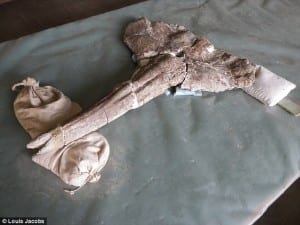The marine mammal’s remains were unearthed 459 miles from the ocean; East Africa was flatter, wet and covered in forest.
London’s Daily Mail covered the research of SMU paleontologist Louis L. Jacobs, a professor in the Roy M. Huffington Department of Earth Sciences of SMU’s Dedman College of Humanities and Sciences.
Jacobs is co-author of a study published in the Proceedings of the National Academy of Sciences.
Findings of the research provide the first constraint on the start of uplift of East African terrain from near sea level.
Uplift associated with the Great Rift Valley of East Africa and the environmental changes it produced have puzzled scientists for decades because the timing and starting elevation have been poorly identified.
Jacobs and his colleagues tapped a fossil from the most precisely dated beaked whale in the world — and the only stranded whale ever found so far inland on the African continent — to pinpoint for the first time a date when East Africa’s mysterious elevation began.
The 17 million-year-old fossil is from the beaked Ziphiidae whale family. It was discovered 740 kilometers inland at a elevation of 620 meters in modern Kenya’s harsh desert region.


The article published March 17, 2015.
EXCERPT:
By Richard Gray
Daily Mail
A whale that swam hundreds of miles up an African river after taking a wrong turn 17 million years ago is helping shed light on a key moment in human evolution.Palaeontologists discovered the fossilised remains of the ancient ancestor to modern beaked whales in the middle of one of the harshest desert areas of Turkana, Kenya.
It has allowed scientists to pinpoint when the landscape in east Africa began to change as the land around the Great Rift Valley began to rise up.
This was a crucial moment in human evolution from primates as it created the dry open habitats that led our ape-like ancestors to walk upright for the first time.
They say that for the whale to have travelled so far inland in a river the area must have been much wetter, far flatter and dominated by forests.
Professor Louis Jacobs, a vertebrate palaeontologist at Southern Methodist University in Dallas who led the study, said: ‘The whale was stranded up river at a time when east Africa was at sea level and was covered with forest and jungle.
‘As that part of the continent rose up, that caused the climate to become drier and drier. So over millions of years, forest gave way to grasslands.
‘Primates evolved to adapt to grasslands and dry country. And that’s when – in human evolution – the primates started to walk upright.’
The whale fossil was first discovered in Loperot, west Turkana, Kenya in 1964 by palaeontologist James Mead, a curator at the Smithsonian Instution at the time.
Follow SMUResearch.com on twitter at @smuresearch.
SMU is a nationally ranked private university in Dallas founded 100 years ago. Today, SMU enrolls nearly 11,000 students who benefit from the academic opportunities and international reach of seven degree-granting schools. For more information see www.smu.edu.
SMU has an uplink facility located on campus for live TV, radio, or online interviews. To speak with an SMU expert or book an SMU guest in the studio, call SMU News & Communications at 214-768-7650.


